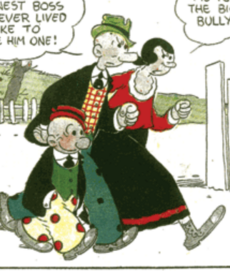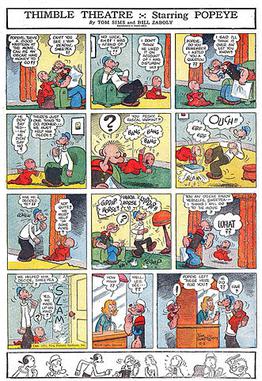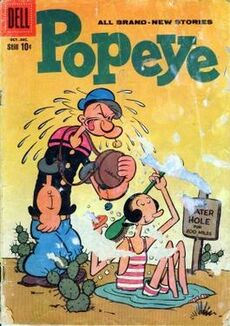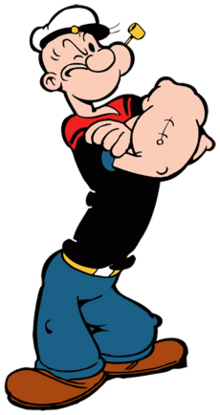Popeye facts for kids
Quick facts for kids Popeye the Sailor Man |
|
|---|---|
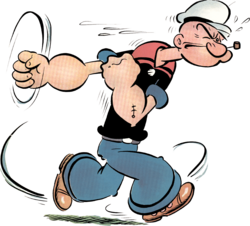 |
|
| Publication information | |
| Publisher | King Features Syndicate |
| First appearance | Thimble Theatre (1929) |
| Created by | E. C. Segar |
| Voiced by |
Voice actor
William Costello (1933–1935)
Jack Mercer (1934–1945, 1947–1984) Floyd Buckley (1936–1937 radio appearances, 1937 Bluebird Records records, 1945–1946 cartoons) Harry Foster Welch (1946–1947, 1960s Peter Pan Records records) Mae Questel (1945–1946; cartoons) Candy Candido (I'm Popeye the Sailor Man/The Little White Duck) Allen Swift (Official TV Popeye Record Album, Popeye's Favorite Sea Shanties, Start commercial) Maurice LaMarche (1987–1990) Jeff Bergman (1989–1996, commercials) Wally Wingert (Popeye and the Quest For the Woolly Mammoth, Popeye: The Rescue, Popeye and the Sunken Treasure) Billy West (Minute Maid commercial, Popeye's Voyage: The Quest for Pappy, Drawn Together, Bank of America commercial) Tom Kenny (2014 animation test) Joe Newton (Popeye's Island Adventures) |
| In-story information | |
| Partnerships | Olive Oyl (girlfriend) |
| Supporting character of | Sons
|
Popeye the Sailor Man is a famous cartoon character created by E. C. Segar. He first appeared on January 17, 1929, in a daily comic strip called Thimble Theatre. Even though the strip was already ten years old, Popeye quickly became the main character. Thimble Theatre became very popular in the 1930s.
Popeye became the boyfriend of Olive Oyl, another character from the strip. Segar also introduced other important characters like Popeye's adopted son Swee'Pea and his friend J. Wellington Wimpy. His main enemies included the Sea Hag and Bluto.
After Segar passed away in 1938, the Thimble Theatre comic strip continued. It was later renamed Popeye. Many writers and artists worked on it, especially Segar's assistant, Bud Sagendorf. Today, new Popeye comic strips are still released on Sundays.
In 1933, Max Fleischer turned the Thimble Theatre characters into animated cartoons for movies. These cartoons were very popular in the 1930s. Production continued until 1957. During World War II, some cartoons even included messages to support the Allies. These old cartoons are now owned by Turner Entertainment and distributed by Warner Bros..
Over the years, Popeye has appeared in many forms. He has been in comic books, TV shows, video games, and hundreds of advertisements. He even starred in a live-action movie in 1980, played by Robin Williams. In 2002, TV Guide ranked Popeye as the 20th greatest cartoon character ever.
Contents
Inspiration for Popeye
The character Popeye was likely inspired by a real person. This person was Frank "Rocky" Fiegel, a strong worker from Chester, Illinois. He was known for getting into fights. People thought he might have been a professional boxer.
However, Fiegel was also kind to children, giving them candy and treats. E.C. Segar, the creator of Popeye, remembered Fiegel when he made the character. Fiegel was described as being "just like the fictional spinach-loving mariner." He was a one-eyed, pipe-smoking man with a strong chin.
Popeye's Character and Powers
Popeye's story and personality can change depending on if you're reading the comics or watching the cartoons. When he first appeared, Popeye's super strength came from rubbing the feathers of a special chicken called Bernice, a "whiffle hen." This made him very lucky and strong.
By late 1929, Popeye's strength became a regular part of his character. By 1932, spinach was shown as the main source of his power. In Segar's comic strip, Popeye was usually super strong all the time. He only sometimes needed extra spinach to boost his strength.
However, in the Fleischer Studios cartoons, Popeye always ate a can of spinach to become super strong. This is how most people remember him. Swee'Pea is Popeye's adopted child in the comics. But in the cartoons, his relationship with Popeye can be different.
Popeye's stories don't always follow a strict timeline. He often seems uneducated and without manners. Yet, he can solve problems that even police or scientists can't figure out. He has shown skills like a detective, a scientist, and a diplomat.
In the animated cartoons, Popeye's pipe is very useful. It can be a cutting torch, a jet engine, a propeller, or even a musical instrument. He sometimes even sucks the whole spinach can through his pipe! Since the 1970s, Popeye is rarely shown smoking tobacco from his pipe.
The cartoons often feature a love triangle between Popeye, Olive Oyl, and Bluto. Bluto is always trying to win Olive over, but Popeye always tries his best to please Olive and overcome any challenge.
Popeye in Comics
The Thimble Theatre and Popeye Comic Strips
| Thimble Theatre / Popeye | |
|---|---|
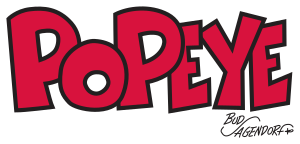 |
|
| Author(s) | E. C. Segar (creator, December 1919 – December 1937, May–August 1938) Doc Winner (December 1937–May 1938) Tom Sims & Doc Winner (August 1938 – December 1939) Bela Zaboly & Tom Sims (December 1939 – December 1954 (daily strip), December 1939 – September 1959 (Sunday strip)) Bela Zaboly & Ralph Stein (December 1954 – August 1959, daily strip only) Bud Sagendorf (August 1959 – February 1986 (daily strip), September 1959 – September 1994 (Sunday strip)) Bobby London (February 1986 – July 1992, daily strip only) Hy Eisman (September 1994 – May 2022, Sunday strip only) R. K. Milholland (June 2022 – present, Sunday strip only) |
| Website | |
| Current status/schedule | New strips on Sundays, reprints Monday through Saturday |
| Launch date | December 19, 1919 |
| End date | July 30, 1992 (last first-run daily strip, Sunday strips continue) |
| Syndicate(s) | King Features Syndicate |
| Publisher(s) | King Features Syndicate |
| Genre(s) | Humor, adventure |
Segar's Thimble Theatre comic strip first appeared on December 19, 1919. It was published by King Features Syndicate. At first, the strip didn't have a huge audience. But it slowly gained more fans in the 1920s. By the end of its first ten years, it was in over a dozen newspapers.
The first main characters were Harold Hamgravy (Ham Gravy) and his girlfriend, Olive Oyl. The strip started with them acting out different stories in a theater style. But soon, it became a series of funny daily adventures about Ham Gravy and Olive Oyl.
In 1922, Segar began telling longer stories, sometimes lasting months. By 1923, the strip became a comedy-adventure story. It focused on Ham, Olive, and Olive's brother, Castor Oyl. Castor and Olive's parents, Cole and Nana Oyl, also appeared often.
Popeye first showed up in the strip on January 17, 1929. He was a small character at first. He was hired by Castor Oyl and Ham Gravy for a trip. Popeye left the strip after this adventure. But readers liked him so much that he came back just five weeks later.
Popeye became so popular that he got a bigger role in the strip. More newspapers started carrying it. Olive Oyl eventually left Ham to become Popeye's girlfriend in March 1930. Ham Gravy then stopped being a regular character.
Over the years, Olive sometimes seemed unsure about Popeye. Castor Oyl continued his get-rich-quick schemes with Popeye. But by 1931, Castor became a detective. As Castor appeared less, J. Wellington Wimpy was introduced. Wimpy was a polite but lazy character who loved hamburgers. He would famously say he'd "gladly pay you Tuesday for a hamburger today." Wimpy became a major character alongside Popeye and Olive.
In 1931, Thimble Theatre was renamed Thimble Theatre Starring Popeye. It was later simply called Popeye, which is its name today.
In July 1933, Popeye found a baby in the mail and adopted him, naming him Swee'Pea. Other characters added later included George W. Geezil, a shoemaker who disliked Wimpy. There was also Rough-House, a diner owner who often dealt with Wimpy. Eugene the Jeep, a magical yellow animal from Africa, also joined. The Sea Hag, a pirate and the last witch on Earth, became a villain. Alice the Goon, a large creature who was the Sea Hag's helper, later became Swee'Pea's babysitter. Popeye's father, Poopdeck Pappy, and a caveman named Toar also appeared.
Segar's comic strip was different from the cartoons. The stories were more detailed and often lasted a long time. They had more verbal humor and many characters not seen in the cartoons. Spinach was used less often. Bluto only appeared in one story arc.
Thimble Theatre became one of King Features' most popular strips in the 1930s. By 1938, it was in 500 newspapers. Over 600 different "Popeye" products were sold. The strip continued after Segar's death in 1938. It is still one of the longest-running comic strips today.
Artists After Segar
After Segar became ill and passed away in 1938, many people worked on the strip. Tom Sims became the writer in August 1938. Doc Winner and then Bela Zaboly drew the strip. Later, Ralph Stein took over writing the daily strip.
In 1959, Bud Sagendorf took over both the daily and Sunday strips. Sagendorf had been Segar's assistant. He tried to keep Segar's classic style. He also used many older characters from Segar's time. Sagendorf drew the daily strip until 1986 and the Sunday strip until his death in 1994.
From 1986 to 1992, Bobby London wrote and drew the daily strip. His stories updated Popeye's world but kept the original spirit. One story showed Popeye fighting different versions of Bluto. The Sunday strip was drawn by Hy Eisman from 1994 to 2022. After Eisman retired, R. K. Milholland took over the Sunday strip. The daily strip has shown reruns of Sagendorf's work since 1992.
Copyright Information
Some of Popeye's early comic strips became available for public use in most countries in 2009. This happened 70 years after his creator, Segar, passed away. However, in the United States, the original Thimble Theatre strip that introduced Popeye became available for public use on January 1, 2025. This is because it was created as a "work for hire" for King Features Syndicate.
Even though some early comics are now freely available, King Features still owns the rights to Popeye's name and image. These rights, called trademarks, do not expire as long as they are used. King Features has used the Popeye trademark since 1931.
Popeye in Comic Books
Popeye has appeared in many comic books. His main series ran from 1948 to 1984. It was published by different companies like Dell Comics and Gold Key Comics. Bud Sagendorf often wrote and drew these comics. In these stories, Popeye sometimes acted like a crimefighter.
Popeye comics were also made outside the United States. In Japan, Popeye had his own manga series from 1961 to 1965. In Italy, comics were produced for the European market from 1963 to 1994.
In 1999, for Popeye's 70th anniversary, a comic book called The Wedding of Popeye and Olive Oyl was released. It showed Popeye and Olive Oyl finally getting married after many years. However, this marriage hasn't been shown in all other Popeye stories since then.
In 2012, a new 12-issue comic book series was published by IDW Publishing. It aimed to bring back the feeling of Segar's original comics. Critics praised the series for its writing and art.
Popeye in Webcomics
In January 2019, King Features Syndicate launched a webcomic called Popeye's Cartoon Club. This was to celebrate Popeye's 90th anniversary. Many different artists drew the characters in their own styles.
In August 2022, a new webcomic called Olive & Popeye started. It updates twice a week. R. K. Milholland writes and draws the Thursday strips, focusing on Popeye and his family. The Tuesday strips focus on Olive's adventures. These two storylines sometimes cross paths.
Popeye in Animation
Animated Shorts for Theaters
In 1932, King Features agreed with Fleischer Studios to make animated cartoons featuring Popeye. The first cartoon came out in 1933. Popeye cartoons were a regular part of movie theaters for almost 25 years. Billy Costello was the first voice of Popeye. Later, Jack Mercer and Mae Questel also voiced him.
Many characters from the Thimble Theatre comic strip appeared in these cartoons. These included Wimpy, Poopdeck Pappy, and Eugene the Jeep. Thanks to these cartoons, Popeye became even more famous than he was in the comics. By 1938, he was Hollywood's most popular cartoon character.
While Segar used spinach a few times, Max Fleischer made it Popeye's signature power. In almost every cartoon, Popeye gets into a tough spot. Then, a can of spinach appears. Popeye quickly eats it, and his strength becomes amazing. He then easily saves the day, often rescuing Olive Oyl. Spinach could also give Popeye other skills, like acrobatics.
In 1942, Paramount Pictures took over Fleischer Studios and renamed it Famous Studios. Some early cartoons from Famous Studios were about World War II. Popeye fought against enemies, like in the 1942 short You're a Sap, Mr. Jap. In late 1943, Popeye cartoons started being made in color. Famous/Paramount continued making Popeye cartoons until 1957.
In 2001, Cartoon Network created The Popeye Show. It aired the old Fleischer and Famous Studios cartoons. The show tried to make them look like their original movie releases. The series aired 135 Popeye shorts until March 2004.
Original Television Cartoons
In 1960, King Features Syndicate ordered a new series of Popeye cartoons for television. Al Brodax was the producer. Jack Mercer, Mae Questel, and Jackson Beck returned to voice the characters. Many different companies made these cartoons. The animation style was simpler to save money. 220 cartoons were made in just two years.
For these TV cartoons, Bluto's name was changed to "Brutus." King Features thought Paramount owned the rights to the name "Bluto." Many of these cartoons used stories and characters directly from the comic strip, like King Blozo and the Sea Hag.
On September 9, 1978, The All New Popeye Hour started on CBS. This hour-long cartoon series was made by Hanna-Barbera Productions. It tried to look more like the original comic strip. Popeye went back to his original look, and Bluto went back to his original name. Jack Mercer continued to voice Popeye. The show ran until 1983.
Popeye briefly returned to CBS in 1987 with Popeye and Son. This Hanna-Barbera series showed Popeye and Olive as a married couple with a son, Popeye Jr. Popeye Jr. didn't like spinach but ate it for strength. Maurice LaMarche voiced Popeye because Jack Mercer had passed away. The show lasted one season.
In 2004, Lionsgate made an animated TV special called Popeye's Voyage: The Quest for Pappy. This was for Popeye's 75th anniversary. Billy West voiced Popeye. The style was like the 1930s Fleischer cartoons. It featured Swee'Pea, Wimpy, Bluto, Olive Oyl, Poopdeck Pappy, and the Sea Hag.
Web Series
On December 2, 2018, a new Popeye web series called Popeye's Island Adventures started. It was made by WildBrain. This series updated the characters for a younger, modern audience. For example, Popeye grows his own spinach. He also uses a bosun's whistle instead of his pipe. Bluto now tries to steal Popeye's spinach instead of his girlfriend. Olive Oyl is shown as an inventor. The characters look younger, and there is no talking; all actions are shown through movement.
Popeye's Theme Song
| "I'm Popeye the Sailor Man" | |
|---|---|
| Song by Billy Costello later by Jack Mercer |
|
| Released | 1933 |
| Recorded | 1933 |
| Composer(s) | Sammy Lerner |
I'm Popeye the Sailor Man,
I'm Popeye the Sailor Man,
I'm strong to the "finich",
'cause I eats me spinach,
I'm Popeye the Sailor Man!
Popeye's famous theme song, "I'm Popeye the Sailor Man", was written by Sammy Lerner in 1933. It was for Fleischer's first Popeye cartoon. The song has been linked to Popeye ever since. The traditional sea song "The Sailor's Hornpipe" is often played before Popeye's theme.
Who Has Played Popeye
- Billy Costello (1933–1935)
- Harry Foster Welch (1934–1940s, 1946–1947, 1960s)
- Jack Mercer (1934–1945, 1947–1984)
- Floyd Buckley (1936–1937, 1945–1946)
- Mae Questel (1945–1946)
- Allen Swift (1956, 1959, 1960s–1970s)
- Robin Williams (1980; Popeye film)
- Maurice LaMarche (1987–1990; Popeye and Son)
- Jeff Bergman (1989–1996)
- Wally Wingert (1997–1998)
- Billy West (2001, 2004, 2006, 2014)
- Tom Kenny (2014)
- Joe Newton (2018; Popeye's Island Adventures)
Other Popeye Media
Popeye's success in comics and cartoons led to him appearing in many other places. Stephen DeStefano has been the artist drawing Popeye for King Features licensing for over 20 years.
Radio Shows
Popeye had several radio shows from 1935 to 1938. These were 15-minute shows that aired three times a week. Detmar Poppen was the voice of Popeye. Olive Oyl, Wimpy, Bluto, and Swee'Pea also appeared. In the first episode, Popeye adopted a boy named Sonny.
The shows were sponsored by companies like Wheatena cereal and Popsicles. The sponsors often changed the lyrics of Popeye's theme song to mention their products instead of spinach. Only a few of the 204 radio episodes are still available today.
Feature Films
Popeye (1980 Film)
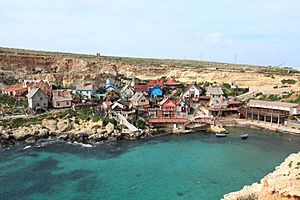
Director Robert Altman made a live-action musical film called Popeye in 1980. Robin Williams played Popeye. This movie was made by Paramount Pictures and Walt Disney Productions. It was filmed mostly in Malta, in a village that is now a tourist attraction called Popeye Village.
The movie earned twice its budget, making it a financial success. While it first received mixed reviews, many critics have come to appreciate it more over time.
Animated Film Plans
In 2010, Sony Pictures Animation announced plans for an animated Popeye movie. Genndy Tartakovsky was set to direct it. He wanted to make the film very artistic and imaginative. In 2014, Tartakovsky showed a short "animation test" that was well-received. However, in 2015, he announced he was no longer working on the project.
In 2020, it was announced that a new Popeye movie was in development with King Features Syndicate, and Genndy Tartakovsky was back on board. However, in 2022, Tartakovsky stated the project was canceled.
Second Live-Action Film
On March 19, 2024, it was announced that a new live-action Popeye film is being developed. Chernin Entertainment is making it, with a screenplay written by Michael Caleo for King Features.
Video Games
- The popular arcade game Donkey Kong was originally planned to be a Popeye game by Shigeru Miyamoto. Popeye would have been Mario, Bluto would have been Donkey Kong, and Olive Oyl would have been Pauline. But Nintendo couldn't get the rights, so they created new characters.
- King Features later licensed the characters to Nintendo for a Popeye arcade game in 1982. It was also released on many home game systems. In the game, you had to avoid Brutus and the Sea Hag while collecting items from Olive Oyl. Eating spinach gave Popeye a short burst of strength to fight back.
- Nintendo also made two Game & Watch games with Popeye.
- A different Popeye game was made for the ZX Spectrum in 1985. It was praised for its large, colorful characters.
- Sigma Enterprises released two Popeye games for the Game Boy in Japan.
- In 1994, Technos Japan released Popeye Beach Volleyball for the Game Gear and Popeye: Tale of the Wicked Witch Sea Hag for the Super Famicom, both only in Japan.
- Midway released a pinball game called Popeye Saves the Earth in 1994.
- In 2005, Bandai Namco released a Game Boy Advance game called Popeye: Rush for Spinach.
- In 2021, an "official Popeye game" was released for the Nintendo Switch, based on the classic arcade game.
- Popeye and Bluto were added as playable characters in the sea combat game World of Warships.
Marketing and Products
From early on, Popeye was used to sell many products. His image appeared on everything from soap to spinach cans. Many of these old items are now rare collector's items.
Games and Toys
- Mattel made many Popeye toys in the late 1950s. These included a Popeye spinach can that squeaked and a Popeye crank guitar.
- In 1961, a commercial for Soaky bubble bath featured Popeye, Olive, and Bluto.
- Kinder produced Popeye figures for their Kinder Surprise eggs in 1991.
- Since 2001, Mezco Toyz has made classic-style Popeye figures.
- Kellytoy makes plush stuffed Popeye characters.
Restaurants
- J. Wellington Wimpy's name was used for the Wimpy restaurant chain, one of the first international fast food places known for hamburgers.
- The popular fast-food chain Popeyes (founded in 1972) was not named after the sailor. It was named after a detective from a movie. However, some Popeye references were used in their early commercials due to a deal with King Features.
Food and Drinks
- Allen Canning Company sells its own "Popeye Spinach" in cans, with Popeye as the mascot.
- In the 1960s, Buitoni Pasta sold Popeye-shaped spinach macaroni.
- Popeye and Olive appeared in commercials for Start orange-flavored breakfast drink in the late 1960s and 1973.
- In the 1970s, Popeye, Bluto, Olive, and Wimpy appeared in commercials for Canada Dry.
- In 1979, Popeye appeared in a Dr Pepper commercial, changing his catchphrase to "...and Popeye the Pepper-man."
- From 1984 to 1990, Popeye and Olive appeared in commercials for Frudesa frozen products.
- In 1987, Popeye appeared with Sonny the Cuckoo Bird in a commercial for Cocoa Puffs cereal.
- Since 1987, Popeye and other characters have appeared in commercials for Ajinomoto food products.
- In 1989-1990, Popeye promoted Instant Quaker Oatmeal.
- In 1999, Popeye and Olive appeared in a Campbell's soup commercial.
- In 2001, Popeye, Bluto, and Olive appeared in a Minute Maid orange juice commercial.
- World Candies Inc. used to make "Popeye-branded" sugar sticks that looked like cigarettes. They now call them "Popeye Candy Sticks" and no longer add red dye to the ends.
- In 2013, a Popeye-branded energy drink was launched in the US.
Sports
- Since 1940, Popeye has been the mascot for Clube de Regatas do Flamengo, a soccer club in Brazil.
- From 1978 to 1985, Japan Airlines used Popeye as a mascot for their ski tours.
- In 2004, two NASCAR racing cars featured Popeye characters to celebrate his 75th anniversary.
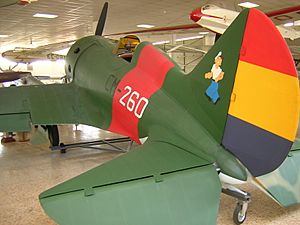
Other Appearances
- In the 1960s, Popeye appeared in ads for Crown gasoline.
- In 1983, Popeye, Olive, and Bluto appeared in a Dutch public service announcement for milk.
- In 1986, Popeye appeared in a commercial for Hitachi refrigerators.
- From 1988 to 1996, Popeye and Olive appeared in Suzuki car commercials in Japan.
- In 1990, Popeye appeared in a public service announcement about ocean pollution. He showed Bluto carelessly dumping trash and encouraged viewers to be careful about littering at sea.
- In 1995, the Popeye comic strip was one of 20 included in a series of U.S. postage stamps.
- In 1999, Popeye & Bluto's Bilge-Rat Barges, a river rafting water ride, opened at Universal's Islands of Adventure theme park. There's also a playground called Me Ship, the Olive.
- In 2012, King Features Syndicate worked with the band Wilco to make an animated music video for their song "Dawned on Me," featuring Popeye and friends.
- In 2014, Popeye characters appeared in a Bank of America commercial.
Popeye & Friends Character Trail
Chester, Illinois, E. C. Segar's hometown, has a statue of Popeye. In 2006, they started the Popeye & Friends Character Trail. Each year, they add new statues honoring other characters from the Thimble Theatre comic strip.
The statues include:
- Popeye (1977)
- J. Wellington Wimpy (2006)
- Olive Oyl, Swee'Pea, and Jeep (2007)
- Bluto (2008)
- Castor Oyl and Whiffle Hen (2009)
- Sea Hag and Bernard (2010)
- Cole Oyl (2011)
- Alice the Goon and her Goon-child (2012)
- Poopdeck Pappy (2013)
- Professor Wotasnozzle (2014)
- RoughHouse (2015)
- Pipeye, Pupeye, Peepeye, and Poopeye (Popeye's four nephews) (2016)
- King Blozo (2017)
- Nana Oyl (2018)
- Popeye's Pups (September 2019)
- Sherlock & Segar (December 2019)
- Toar (2020)
- Harold Hamgravy (2021)
- Oscar (2022)
Frank "Rocky" Fiegel, who inspired Popeye, passed away on March 24, 1947. His gravestone has an image of Popeye on it.
Other people from Chester also inspired Segar's characters. Dora Paskel, a tall woman who ran a general store, was the inspiration for Olive Oyl. William "Windy Bill" Schuchert, a larger man who owned the local opera house, inspired J. Wellington Wimpy.
Cultural Impact
Many people see Popeye as an early version of the superheroes we know today. In medicine, a certain type of bicep muscle tear is even called the "Popeye sign."
In 1981, the Nintendo video game Donkey Kong was originally planned to be a Popeye game. The characters Mario, Donkey Kong, and Pauline were originally going to be Popeye, Bluto, and Olive Oyl.
The Popeye Dance
The Popeye was a popular dance in the early 1960s, starting around 1962 in New Orleans. Dancers would shuffle their feet and move their arms like Popeye, pretending to raise a pipe to their mouth. The dance was mentioned in several songs.
Spinach and Popeye
Popeye's strength was first linked to a magical chicken. Later, it was linked to spinach. The popularity of Popeye helped increase spinach sales. Studies have shown that children might eat more vegetables after watching Popeye cartoons.
The town of Crystal City, Texas, which grows a lot of spinach, has a statue of Popeye. There are also statues in Springdale and Alma, Arkansas, which call themselves "The Spinach Capital of the World." These statues are at canning plants that sell Popeye-branded spinach.
There's a common story that Popeye's link to spinach came from a mistake. The story says a scientist misplaced a decimal point in an 1870 measurement of spinach's iron content, making it seem ten times higher. However, the error was a measurement mistake corrected in the 1930s. Also, in one 1932 episode, Popeye said he ate spinach because it was "full of Vitamin A," not iron.
New Words from Popeye
The comic strip helped make the word "goon" popular. A "goon" means a tough helper or lackey. In Popeye's world, goons were large human-like creatures often used by the Sea Hag. Alice the Goon, a female goon, sometimes appeared in cartoons as a friendly character.
Eugene the Jeep was introduced in the comic strip in 1936. Two years later, the term "jeep wagons" was used. This was later shortened to "jeep" and became widely used during World War II.
Events and Honors
The Popeye Picnic is held every year in Chester, Illinois, after Labor Day. Fans from all over the world attend.
To celebrate Popeye's 75th anniversary, the Empire State Building lit its tower lights green from January 16–18, 2004. This honored Popeye's love of spinach. It was the only time the Empire State Building celebrated a comic strip character's anniversary.
Popeye Characters
Characters from E. C. Segar's Comic Strips
- Popeye the Sailor (first appeared January 17, 1929)
- Olive Oyl (first appeared December 19, 1919)
- Swee'Pea (Popeye's adopted baby son in comics, Olive's cousin in cartoons) (first appeared July 24, 1933)
- J. Wellington Wimpy (first appeared May 3, 1931)
- Bluto/Brutus (first appeared September 12, 1932)
- Eugene the Jeep (first appeared March 17, 1936)
- The Sea Hag (first appeared January 6, 1930)
- The Sea Hag's vultures, including Bernard
- Alice the Goon (first appeared December 10, 1933) and other Goons
- Rough House (a cook who runs a diner) (first appeared May 24, 1931)
- George W. Geezil (the shoemaker who dislikes Wimpy) (first appeared November 11, 1932)
- Ham Gravy (Olive Oyl's first boyfriend) (first appeared December 19, 1919)
- Castor Oyl (Olive Oyl's brother) (first appeared January 14, 1920)
- Cole Oyl (Olive Oyl's father)
- Nana Oyl (Olive Oyl's mother)
- Poopdeck Pappy (Popeye's 99-year-old father) (first appeared September 26, 1936)
- Professor O. G. Watasnozzle (a character with a large nose)
Characters from Cartoons
- Peepeye, Poopeye, Pupeye, and Pipeye (Popeye's identical nephews in the Fleischer Studio shorts)
- Shorty (Popeye's shipmate in some World War II cartoons)
- Popeye Jr. (son of Popeye and Olive Oyl, from the Popeye and Son series)
- Tank (son of Bluto, from the Popeye and Son series)
Popeye's Filmography
Theatrical Films
- Popeye the Sailor (1933–1942, 109 cartoons by Fleischer Studios)
- Popeye the Sailor (1942–1957, 122 cartoons by Famous Studios)
- Popeye (1980, live-action film by Paramount Pictures and Walt Disney Pictures)
Television Shows
- Popeye the Sailor (1960–1962, ABC, 220 cartoons)
- The All New Popeye Hour (1978–1983, CBS, 167 cartoons) Also known as The Popeye and Olive Comedy Show.
- Popeye and Son (1987–1988, CBS, 26 cartoons)
Television Specials
- Popeye Meets the Man Who Hated Laughter (1972, ABC)
- The Popeye Valentine Special: Sweethearts at Sea (1979, CBS)
- Popeye's Voyage: The Quest for Pappy (2004, Fox)
DVD Collections
Theatrical Cartoons
- Popeye the Sailor: 1933–1938, Volume 1 (released July 31, 2007)
- Popeye the Sailor: 1938–1940, Volume 2 (released June 17, 2008)
- Popeye the Sailor: 1941–1943, Volume 3 (released November 4, 2008)
- Popeye the Sailor: The 1940s, Volume 1 (released December 11, 2018)
- Popeye the Sailor: The 1940s, Volume 2 (released June 18, 2019)
- Popeye the Sailor: The 1940s, Volume 3 (released September 17, 2019)
TV Cartoons
- Popeye the Sailor: The 1960s Classics, Volume 1 (released May 7, 2013)
Fun Facts About Popeye
- Popeye was a very early type of superhero. He appeared before many of the famous superheroes we know today in comic books.
- In medicine, when a bicep muscle tears and bulges, doctors sometimes call it the "Popeye sign".
- The famous 1981 Nintendo video game Donkey Kong was almost a Popeye game! Mario (who was called Jumpman then) was supposed to be Popeye. Donkey Kong was going to be Bluto, and Pauline was going to be Olive Oyl. But Nintendo couldn't get the rights to use Popeye's characters, so they made their own.
- The "Popeye" was a popular dance in the early 1960s. It started in New Orleans around 1962. Dancers would shuffle their feet and move their arms like Popeye smoking his pipe.
- Every year, a "Popeye Picnic" is held in Chester, Illinois. This is the town where E. C. Segar, Popeye's creator, was born. Fans come from all over the world to celebrate Popeye.
- To celebrate Popeye's 75th anniversary in 2004, the Empire State Building in New York City lit up its tower lights green. This was a special tribute to Popeye's love for spinach. It was the only time the building ever celebrated a comic strip character's birthday!
See also
 In Spanish: Popeye para niños
In Spanish: Popeye para niños


